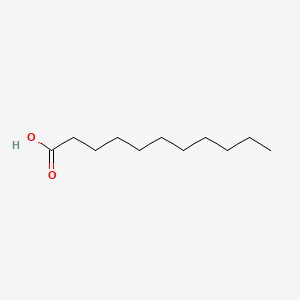| MeSH term | MeSH ID | Detail |
|---|---|---|
| Hemolysis | D006461 | 131 associated lipids |
| Alopecia | D000505 | 14 associated lipids |
UNDECANOIC ACID
UNDECANOIC ACID is a lipid of Fatty Acyls (FA) class. The involved functions are known as Anabolism, Mitosis, Transcriptional Activation, Mismatch Repair and Transcription, Genetic. Undecanoic acid often locates in Protoplasm and spindle microtubule. The associated genes with UNDECANOIC ACID are TERT gene. The related lipids are Fatty Acids and undecanoic acid.
Cross Reference
Introduction
To understand associated biological information of UNDECANOIC ACID, we collected biological information of abnormalities, associated pathways, cellular/molecular locations, biological functions, related genes/proteins, lipids and common seen animal/experimental models with organized paragraphs from literatures.
What diseases are associated with UNDECANOIC ACID?
There are no associated biomedical information in the current reference collection.
Possible diseases from mapped MeSH terms on references
We collected disease MeSH terms mapped to the references associated with UNDECANOIC ACID
PubChem Associated disorders and diseases
What pathways are associated with UNDECANOIC ACID
There are no associated biomedical information in the current reference collection.
PubChem Biomolecular Interactions and Pathways
Link to PubChem Biomolecular Interactions and PathwaysWhat cellular locations are associated with UNDECANOIC ACID?
Visualization in cellular structure
Associated locations are in red color. Not associated locations are in black.
Related references are published most in these journals:
| Location | Cross reference | Weighted score | Related literatures |
|---|
What functions are associated with UNDECANOIC ACID?
Related references are published most in these journals:
| Function | Cross reference | Weighted score | Related literatures |
|---|
What lipids are associated with UNDECANOIC ACID?
Related references are published most in these journals:
| Lipid concept | Cross reference | Weighted score | Related literatures |
|---|
What genes are associated with UNDECANOIC ACID?
Related references are published most in these journals:
| Gene | Cross reference | Weighted score | Related literatures |
|---|
What common seen animal models are associated with UNDECANOIC ACID?
There are no associated biomedical information in the current reference collection.
NCBI Entrez Crosslinks
All references with UNDECANOIC ACID
Download all related citations| Authors | Title | Published | Journal | PubMed Link |
|---|---|---|---|---|
| Melehan KL et al. | Increased sexual desire with exogenous testosterone administration in men with obstructive sleep apnea: a randomized placebo-controlled study. | 2016 | Andrology | pmid:26610430 |
| Jain A et al. | Ga labeled fatty acids for cardiac metabolic imaging: Influence of different bifunctional chelators. | 2016 | Bioorg. Med. Chem. Lett. | pmid:27793567 |
| Kulsing C et al. | Investigations into the separation behaviour of perfluorinated C8 and undecanoic acid modified silica hydride stationary phases. | 2016 | Anal. Chim. Acta | pmid:27016444 |
| Monreal CM et al. | Metabolism of nC11 fatty acid fed to Trichoderma koningii and Penicillium janthinellum II: Production of intracellular and extracellular lipids. | 2014 | J Environ Sci Health B | pmid:25310811 |
| Chahal A et al. | Metabolism of n-C10:0 and n-C11:0 fatty acids by Trichoderma koningii, Penicillium janthinellum and their mixed culture: I. Biomass and CO2 production, and allocation of intracellular lipids. | 2014 | J Environ Sci Health B | pmid:25310810 |
| Huang Q et al. | A medium-chain fatty acid receptor Gpr84 in zebrafish: expression pattern and roles in immune regulation. | 2014 | Dev. Comp. Immunol. | pmid:24704214 |
| Wierckx K et al. | Short- and long-term clinical skin effects of testosterone treatment in trans men. | 2014 | J Sex Med | pmid:24344810 |
| Casford MT et al. | The structure of lipid bilayers adsorbed on activated carboxy-terminated monolayers investigated by sum frequency generation spectroscopy. | 2014 | J Phys Chem B | pmid:24628457 |
| Almodóvar J et al. | Chitosan-heparin polyelectrolyte multilayers on cortical bone: periosteum-mimetic, cytophilic, antibacterial coatings. | 2013 | Biotechnol. Bioeng. | pmid:22903591 |
| Guo H et al. | Influences of hydrocarbon linkers on the receptor binding affinities of gonadotropin-releasing hormone peptides. | 2013 | Bioorg. Med. Chem. Lett. | pmid:24018188 |
